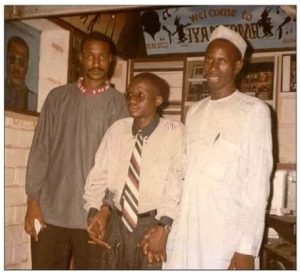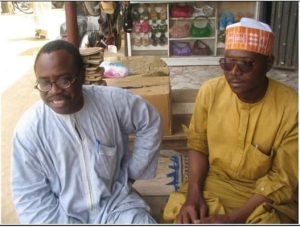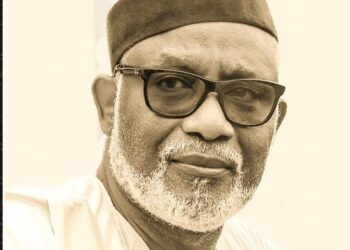
As noted earlier, the initial shaping of the Hausa video film soundtrack was through the singing in Munkar, and later combining singing and music of In Da So Da Ƙauna. A series of chance encounters, rather than deliberate marketing strategies, shaped the appearance of the dance routines in the early Hausa video films 1996.
In early 1996, Ɗan Azimi Baba, a novelist and also a bandiri (frame drum used in mystical religious performances) musician and singer, and based in Kano, wrote a love song he called Badaƙala about two girls. Ɗan Azimi Baba said he was inspired not by Hindi films (which he admitted to being an avid fan), but by Middle Eastern folklore of heroes such as Antar Shaddad, an Arab hero from Egypt to Morocco (which learned from the popular street corner preacher, Ƙalarawi) who, it seemed also sung love serenades.
In an innovative move, he decided to create a sound for the songs with handclaps, hands beating a wooden bench, and eventually empty plastic storage jars (‘jerrycans’).
When he heard Ado Ahmad Gidan Dabino’s soundtrack for the official In Da So Da Ƙauna, he immediately got the musician, Nasir Usman Ishaq Gwale, to set the words of Badaƙala to music. The resultant audio tape was meant to be sold in the markets as an independent new music production.
In a chance encounter with Hamisu Lamiɗo Iyan-Tama, a merchant with a boutique in the bustling Sabon Gari market, Ɗan Azimi Baba convinced Iyan-Tama to star in his first film, Bakandamiyar Rikicin Duniya. The film was to be based on a novel, Rikicin Duniya, which Ɗan Azimi wrote in 1992. However, a video film with similar name had already been released in 1991. In a spirit of co-operation, Ɗan Azimi re-titled his own video Bakandamiyar Rikicin Duniya. He also played Badaƙala audio tape for his aspiring star.
This caught Iyan-Tama’s imagination. His boutique was already popular with teenagers aided by a music “dubbing” facility—which makes it possible for him to make pirated commercial recordings from music CDs, then newly entering into the market, and recording them on tape. So, he already had, as it were, an ear for music. Badaƙala and the soundtrack for Bakandamiyar Rikicin Duniya opened yet another lucrative sideline in keyboard music for other modern Hausa musicians, and thus a company, Iyan-Tama Multimedia was born in 1996. Establishing Iyan-Tama Multimedia Studios and migrating to soundtrack music for the burgeoning video film industry was a natural progressing Iyan-Tama’s marketing strategy. Ɗan Azimi Baba then introduced Nasir Usman Ishaq Gwale to Iyan-Tama in 1996.
On his next trip to Dubai where he usually bought his merchandise (and even shooting a film there), Iyan-Tama brought a Yamaha keyboard organ, PSR-220, which was used by Nasir Gwale, by now a consultant-employee at Iyan-Tama Multimedia Studios, to compose the soundtracks for the early Hausa video films.
This partnership was strong but short, for Nasir Gwale tragically died in July 1998. Before his death at 33, he had composed the soundtracks to various Hausa video films, including early notables like In Da So, Wata Rana Sai Labari, Saki Reshe, Ƙaddara, Badaƙala, Kara Da Kiyashi, and Kowa Da Ranarsa.
A collaborative venture between Iyan-Tama Multimedia and Ɗan Azimi Baba’s outfit, RK Studios saw the release of Badaƙala audio tape into the market. The tape, however, was rejected by cassette marketers in Kano. The main reasons were two. First, it contained “kiɗan fiyano” (piano music)—an instrument associated with the Church in northern Nigeria, and therefore avoided by Muslims.
Secondly, Allah was mentioned in the lyrics to the song. To the marketers, this was akin to blasphemy—to utter the name of Allah in a “church” music. The specific section of the “offending” lyrics is:
Ni Zainabu ke ce a rai na / Oh, Zainab, you are in my heart
Ke ce hasken zuciya ta / You are the light of my heart
To Bismillah, za ni fara / I start in the name of Allah
Ba ni basira, ya Tabara / Grant me wisdom, Oh Allah – the Blessed One
Zan waƙe gun masoyiya ta / I am going to sing for my lover
The words, Bismillah (start in the name of Allah) and Tabara (Blessed), in a love song, accompanied by a “Christian” instrument, proved to the marketers a lack of respect for the Creator. In a personal interview I held with the marketer, Rabi’u BK, at Ƙofar Wambai Kano on October 19, 2004, he told me that although he had stocked the tape, he only sold it to those who knew it was there. He was afraid of marketing it openly to avoid backlash from the heavily religious culture that could lead to riots. He also accepted that it was the first ‘modern music’ independent cassette brought to the market.

It was then that Ɗan Azimi decided to create a story around the song, and the result was the video film, Badaƙala. The video explores the issue of gang warfare and turf territoriality in Hausa urban clusters, and was inspired by chop-socky Chinese and American Hollywood fight sequences borrowed from then marginally popular Chinese cinema in Kano. And while its producers insisted it was not a Bollywood rip-off, nevertheless it had distinctly Bollywood and Chinese fight scenes.
They decided, of course, that the audio soundtrack of the tape should accompany the video, but with the addition that the characters—the lovelorn protagonists—in the video will mime the songs to be played in the background—thus creating the first music playback miming of its kind in Hausa video films. The words were set to new music so that there was a difference between the audio tape of Badaƙala that flopped in the market, and the soundtrack for the video. This marked the emergence of mass popular culture in Hausa entertainment, and the Yamaha soft synthesizer was to provide the means to this credibility through an otherwise ordinary Hausa video film, Sangaya, in 1999.
* Abdalla Uba Adamu is a double-Professor (of Science Education, and Media Studies) at Bayero University, Kano. He is a former Vice-Chancellor of the National Open University of Nigeria (NOUN)




